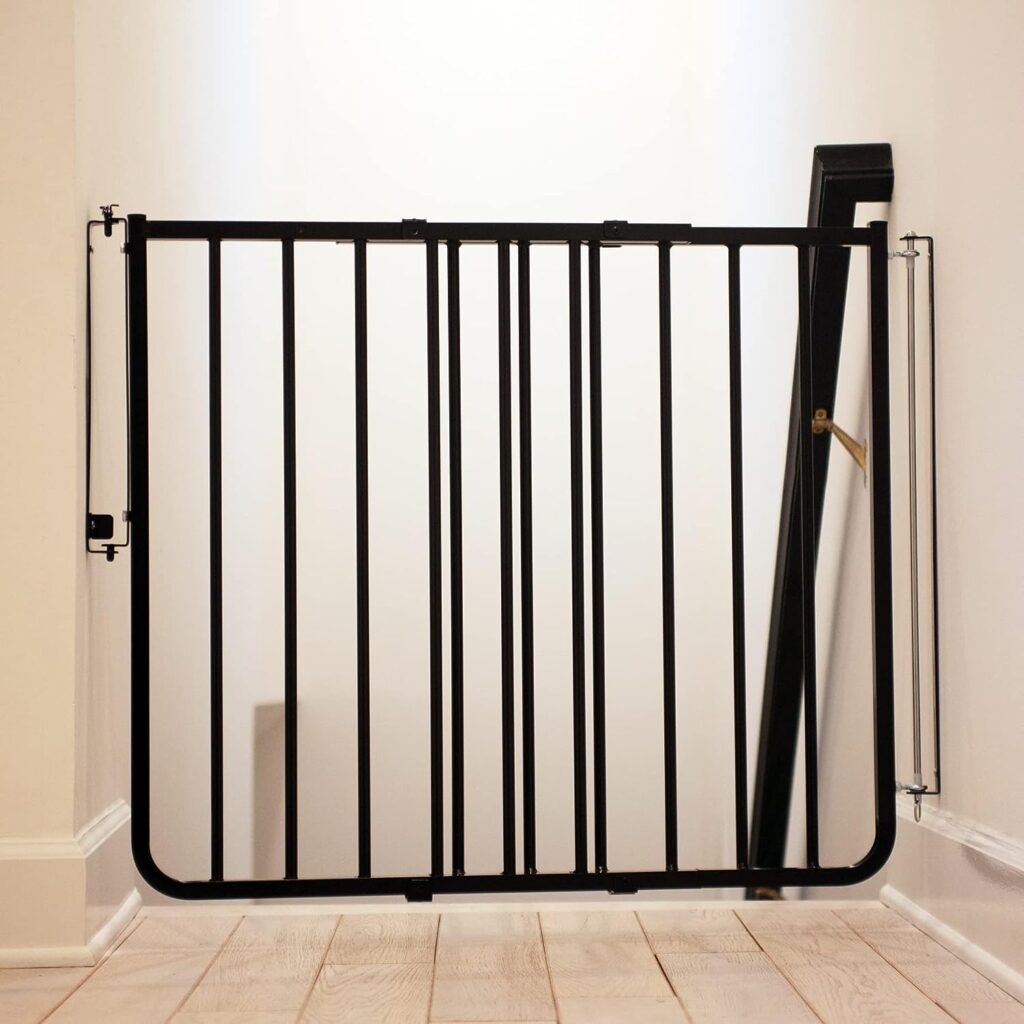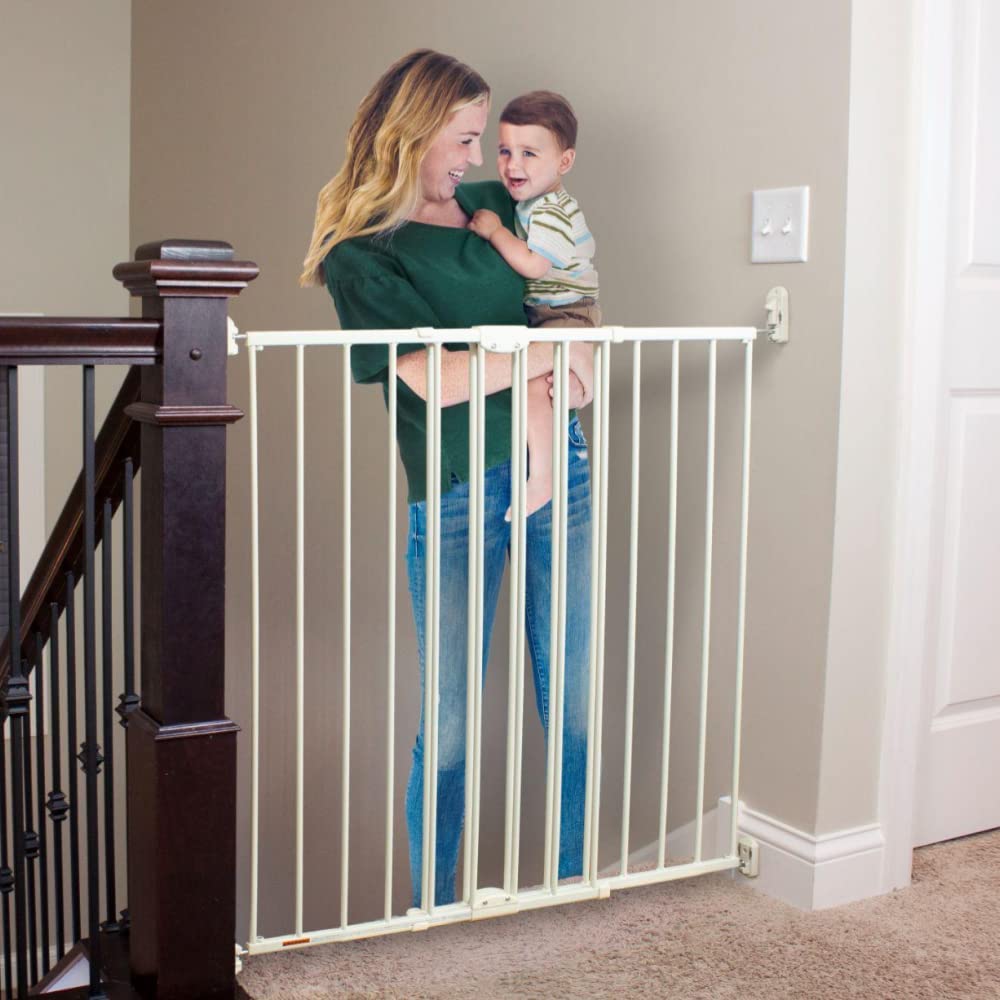It’s baby time! And that means it’s time to start thinking about baby gates.
There are so many things to look for when choosing and installing safety gates and we here at babygatesexpert.com want you to be ready to meet those challenges!
Since you will want to take into consideration several different factors, I decided to share with you this list of my 5 Top Tips when choosing a baby gate for your home.
So let’s get started!
#1: Layout of Your Home and Location of Needed Gates
Take a notebook and start at one end of your home. Walk the length and width of it, notating all the different areas that may need to be blocked off.
You can either make a list of the potentially dangerous areas or even create a sketch of your home, showing the placement of potential baby gates.
Especially consider any stairways which will need baby gates at both ends. Note where you may need extra long gates or narrow spaces that will need specialty gates, i.e. a retractable. Jot down which gates will need to be permanently-mounted (such as at the top of stairs).
Check to make sure that you have proper anchor points where any gate will need to be installed. If you have wide spaces with no anchor points, you may need to invest in a free-standing gate or a play yard set up.
When you are finished with this exercise, you should have a well-laid out plan of how many gates you need, the types necessary, and a full understanding of what it will take to make your home a much safer area for baby to roam.
#2: Your Child’s Age Matters
When it comes to baby gates, it is not necessarily a one-size-fits-all kind of deal.
Younger babies need less area to move around and may be easier to contain to one central area. As they learn to crawl, toddle, and then climb, your baby gates must be able to meet the demand.
You will likely need more gates, stronger gates, or permanently-mounted gates if your child is older, stronger, capable of climbing, or needs more space.
Think of it like this: Babies need to be kept “in”, while toddlers need to be kept “out” of certain areas. Keep this factor in mind when choosing your set up.
If a gate doesn’t have a complicated latch system, this is fine…if you have a smaller baby that only rolls or crawls. But once they learn to pull up, climb, or can solve puzzles, having a gate with a latch that baffles them is going to be super important.
#3: Choose Gate Design Carefully
Not all gates are equal. And there are so many to choose from, it may seem a bit overwhelming. Some of the factors I’ve already mentioned are going to come into play here.
First, only use a pressure-mounted gate in an area that doesn’t require a permanent-mounted one. They tend to be less expensive and don’t leave permanent marks, but they can loosen over time, especially with a rowdy toddler. Keep this factor in mind.
Secondly, think about the design of the gate itself. Does it have vertical slats that are less than 4” apart? Great! If it has horizontal slats, diagonal slats, or a diamond shape made of out of slats, then these can be used as toe-holds that resourceful children can utilize to simply climb over the gate.
Also, I will mention here again, consider the latch design, as well as certain features that the gate may have, such as a self-closing door, a walk-thru door, or a door that can be locked in the open position. What points do you think will make the gate better and easier for you to use, but harder for your child to master?
#4: Measure, Measure, Measure
Gates come in so many shapes and sizes! Look back on your list and make sure that you write down the exact measurements of every opening you need to block off. By having all of these measurements handy in one place, your job will be much easier!
Some gates come with optional extensions, while others have extensions that can be purchased as add-ons. If you need a narrow gate or need to span an odd size opening, you may need to use a retractable gate that can be infinitely adjusted from just a few inches up to several feet.
Also keep in mind that different gates either open fully with a wide swing motion and others have a walk-thru gate, which can vary drastically in width. If you need to be able to pass through with groceries or laundry, always consider these dimensions, as well.
One last note about shapes and sizes, not only do you have choices in terms of length/width, but you also can choose extra-tall gates that may do a better job of deterring a climbing toddler.
#5: Read Parent Reviews
One of the best things you can do with choosing which baby gates to buy and install is to simply read what has worked (or not worked) for other parents.
Real reviews truly can make a difference in helping you decide what gates have the features and qualities that you are personally looking for. Equally important is knowing what annoyances a certain gate may have and whether it is a “con” that you just can’t live with.
There are no perfect gates out there, but by comparing and contrasting what is available on the market, you can more easily narrow down your choices to the ‘best of the best’ and the best value overall.
Here at Baby Gates Expert, we care about real-world reviews and take that into consideration when bringing you our recommendations. We compile information from a multitude of sources to make your decision-making process easier.
We want you to find the best gate possible for your needs and will be here to help you every step of the way!
Happy Baby-Gating!









